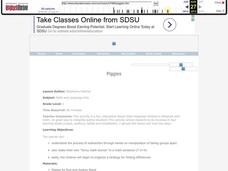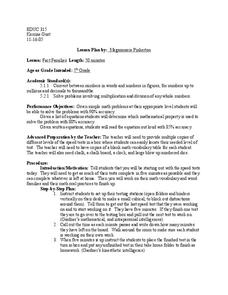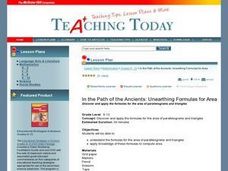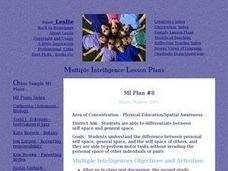Curated OER
Pythagoreum Theorem
Learners practice assessing how to apply the formulas for the area of parallelograms and triangles. They recount the contributions of Pythagoras and apply the theories of the Pythagorean theorem in a group project to calculate the...
Curated OER
Line Ups
Fifth graders describe the lunar cycle. develop an understanding of the order and phases of the moon. Each student in a team contributes orally in order to make a line up of the moon phases in order.
Curated OER
Multisensory Sight-word Strategies
Students engage in a lesson that uses sight word strategies in order to increase reading comprehension. The skills are applicable to rote skill, math facts, formulas, etc... The lesson includes sample exercises for the teacher to use for...
Curated OER
GET'N JIGGY WITH THE JITTERBUG
Twelfth graders research the history of the jitterbug dance through an interactive group project. The goal of the lesson is to get them to execute the dance steps independently with little outside help from the teacher. The steps are...
Curated OER
Piggies
First graders listen to the book, Piggies, and act out the events of the story with premade puffball pigs.
Curated OER
Introducing Linear Terminology
Ninth graders graph linear equations and inequalities in two variables and then, they write equations of lines and find and use the slope and y-intercept
of lines. They use linear equations to model real data and define to define the...
Curated OER
Standard Linear Form
Ninth graders identify and describe the x-intercept as the place where the line crosses the x-axis as it applies to football. They create their own differentiations to reinforce the distinction between the x-intercept and the...
Curated OER
Altimetry
Fifth graders accurately measure the distance to eight points on an uneven surface by conducting a simulation of sattelite altimetry. They create a two-dimensional model of the simulated ocean surface by graphing data from the Radar Run...
Curated OER
Compare and Arrange Whole Numbers Up to 100
Number whizzes investigate integers by arranging them in a specific order. They utilize whole numbers which are given to them and then put them in order up to 100. They also practice using "greater than" or "lesser than" symbols.
Curated OER
Butterflies and Flowers
Students observe and demonstrate the concepts of over, under, and on. Using a cutout of a flower and a butterfly, they identify if the butterfly is over, under, or on the flower. Students complete a worksheet along with the teacher, and...
Curated OER
Fact Families
Fifth graders explore fact families. They solve simple math problems. Students determine which mathematical property is used to solve the given problem. They are given five minutes to complete as many mathematical facts as possible.
Curated OER
House Dimensions
Fourth graders measure the perimeters of several different rooms. They convert the measurements using ratios that allow them to draw the rooms to scale on paper. They draw the dimensions of a house to scale. They measure length to the...
Curated OER
Introduction to Biometrics
Students use the internet to research how biometrics is being used in the real world today. They work together to research hand geometry applications. They share their findings with the class.
Curated OER
Disappearing Magic Factors
Learners identify, through the number of rows and columns, the factors related to the product. In turn, they also discover how to find the missing factor, which is part of the fact family for that product.
Curated OER
Bar Me In
Fourth graders watch a video about constructing bar graphs. They create their own graph and interpret it.
Curated OER
Pennies
Students identify pennies, nickels, dimes, and quarters, and count groups of pennies up to ten. They identify the coins using coin manipulatives, count the pennies on a worksheet, and draw a picture on a two-cent stamp. Students then...
Curated OER
In the Path of the Ancients: Unearthing Formulas for Area
Students apply the formulas for the area of parallelograms and triangles. Through guided practice, students discover the correct way to apply the formulas. Working in pairs, they write their own problems featuring the formulas.
Curated OER
Apples
Students are asked what kinds of vegetables do they like to eat, and what kinds of fruits do they like to eat? They are asked to describe how an apple might taste. Students count the number of green apples, they are told the different...
Curated OER
Self Space
Second graders investigate how to differentiate between self-space and general space of themselves and others.
Curated OER
Immigration Unit
Third graders develop an appreciate for the various cultures that are present in their local community. Through reading and research, they explain how various culture came to live in their area. At the conclusion of the unit, 3rd...
Curated OER
Get Your Pupils Moving While Learning
Use these teaching strategies to get the wiggles out and keep the learning in!
Curated OER
When Clay speaks
Learners listen as the teacher reads "When Clay Sings," by Byrd Taylor. They discuss clay, and view a variety of clay items. Students watch a video clip "Interests in One of a Kind Pots." They watch a demonstration on working with clay....
Curated OER
Dr. Dirt's Archaeology Lab Artifact Analysis
Students simulate analyzing artifacts in archaeological lab by using real techniques that archaeologists use. Students practice measuring skills, drawing, writing, and brainstorming, and make inferences based on evidence.
PBS
Pbs: Mathline: Tessellations Wow! [Pdf]
An integrated geometry lesson on spatial sense in which students identify and use different shapes to create a tessellation. "Through a variety of modalities such as writing, music, art, poetry, and literature, students are introduced to...

























![Pbs: Mathline: Tessellations Wow! [Pdf] Lesson Plan Pbs: Mathline: Tessellations Wow! [Pdf] Lesson Plan](https://d15y2dacu3jp90.cloudfront.net/images/attachment_defaults/resource/large/FPO-knovation.png)